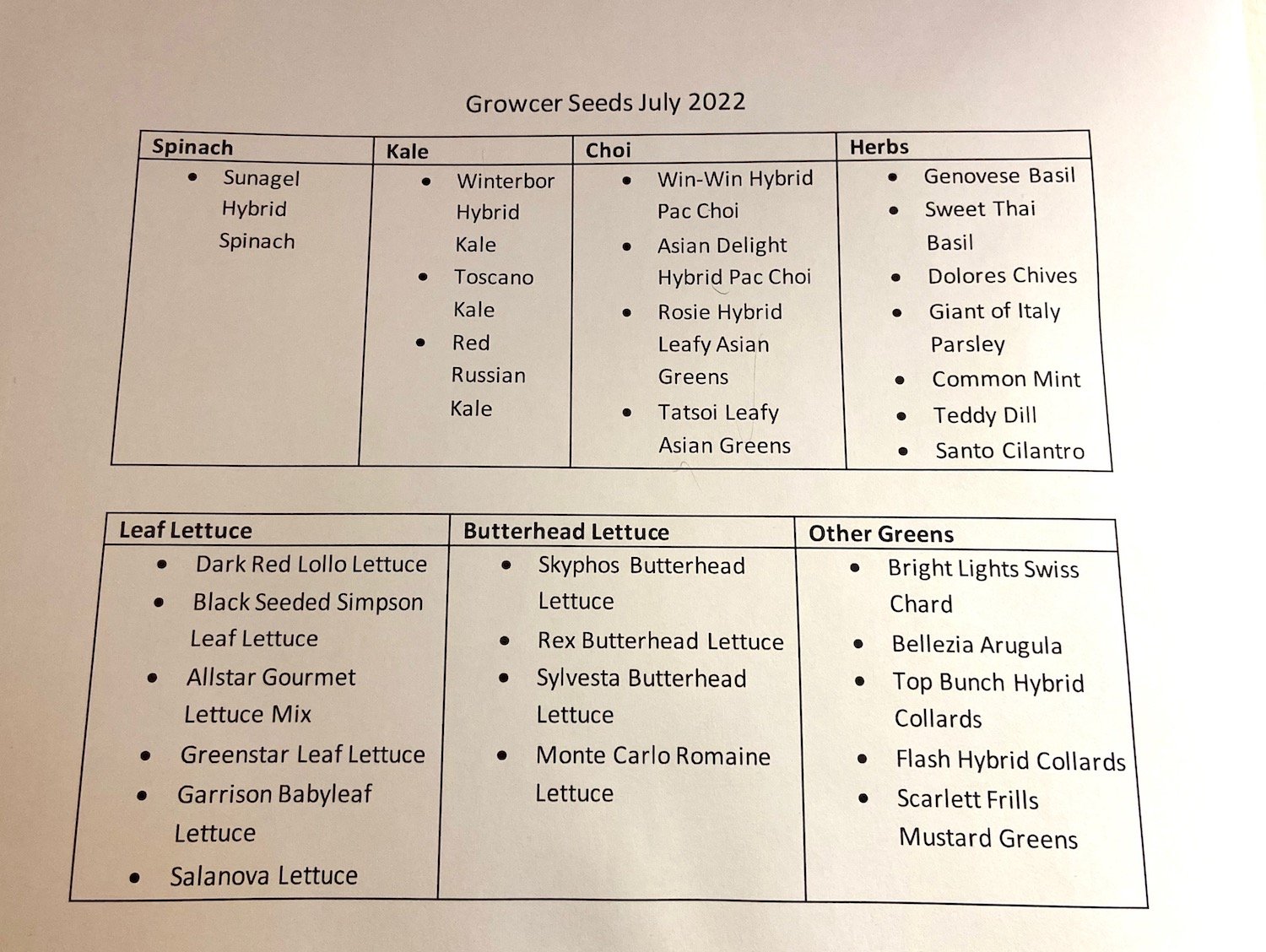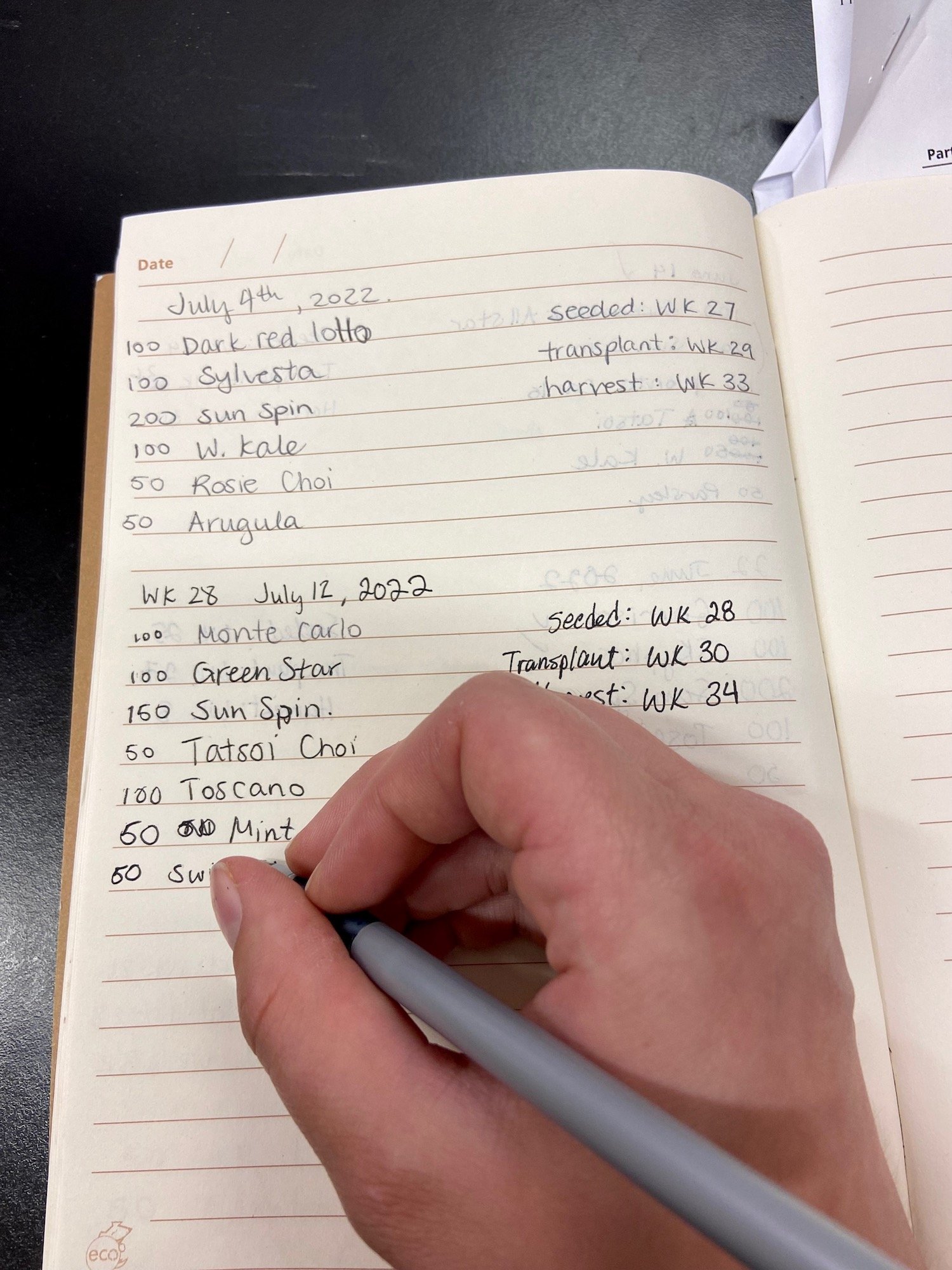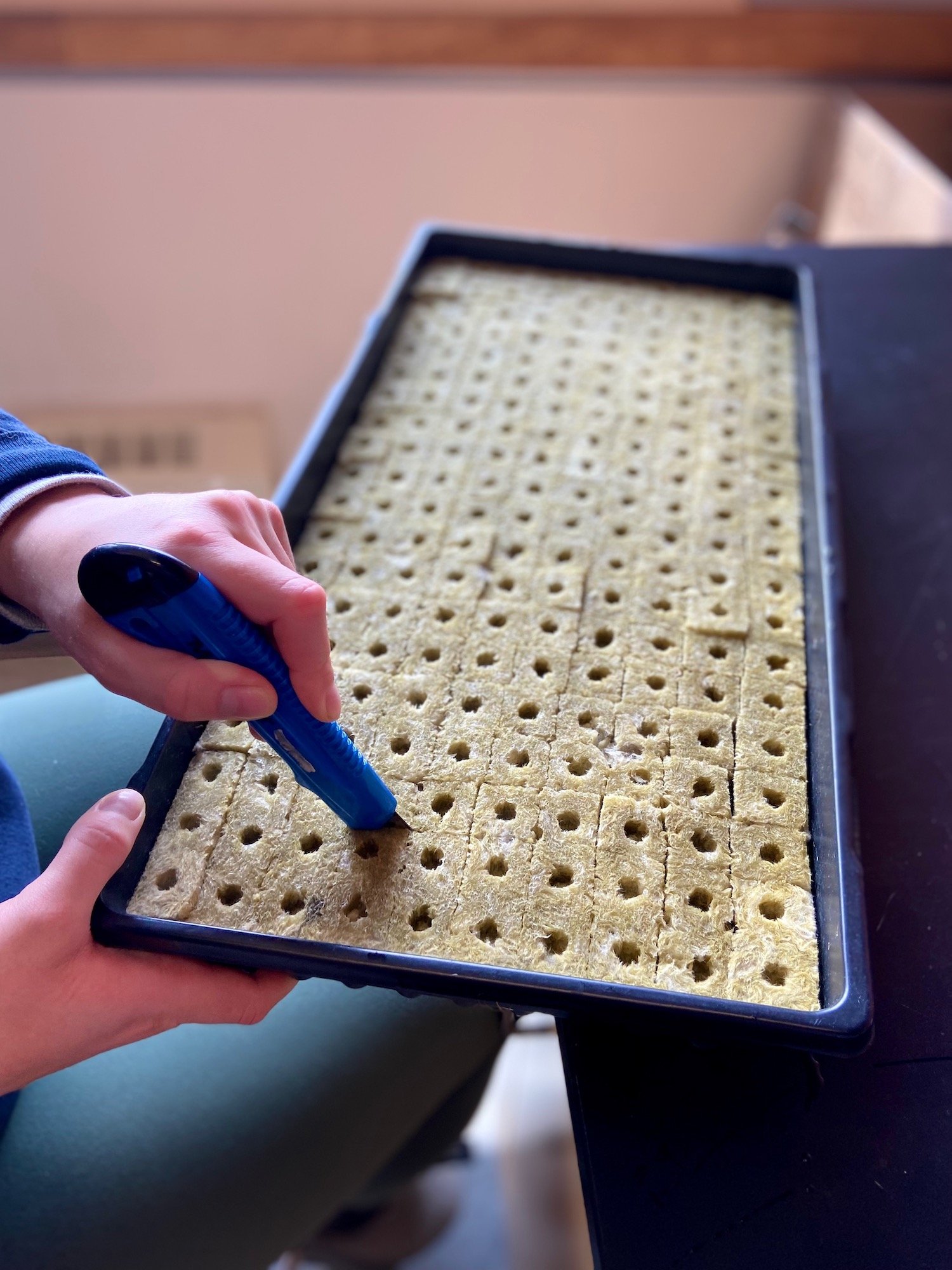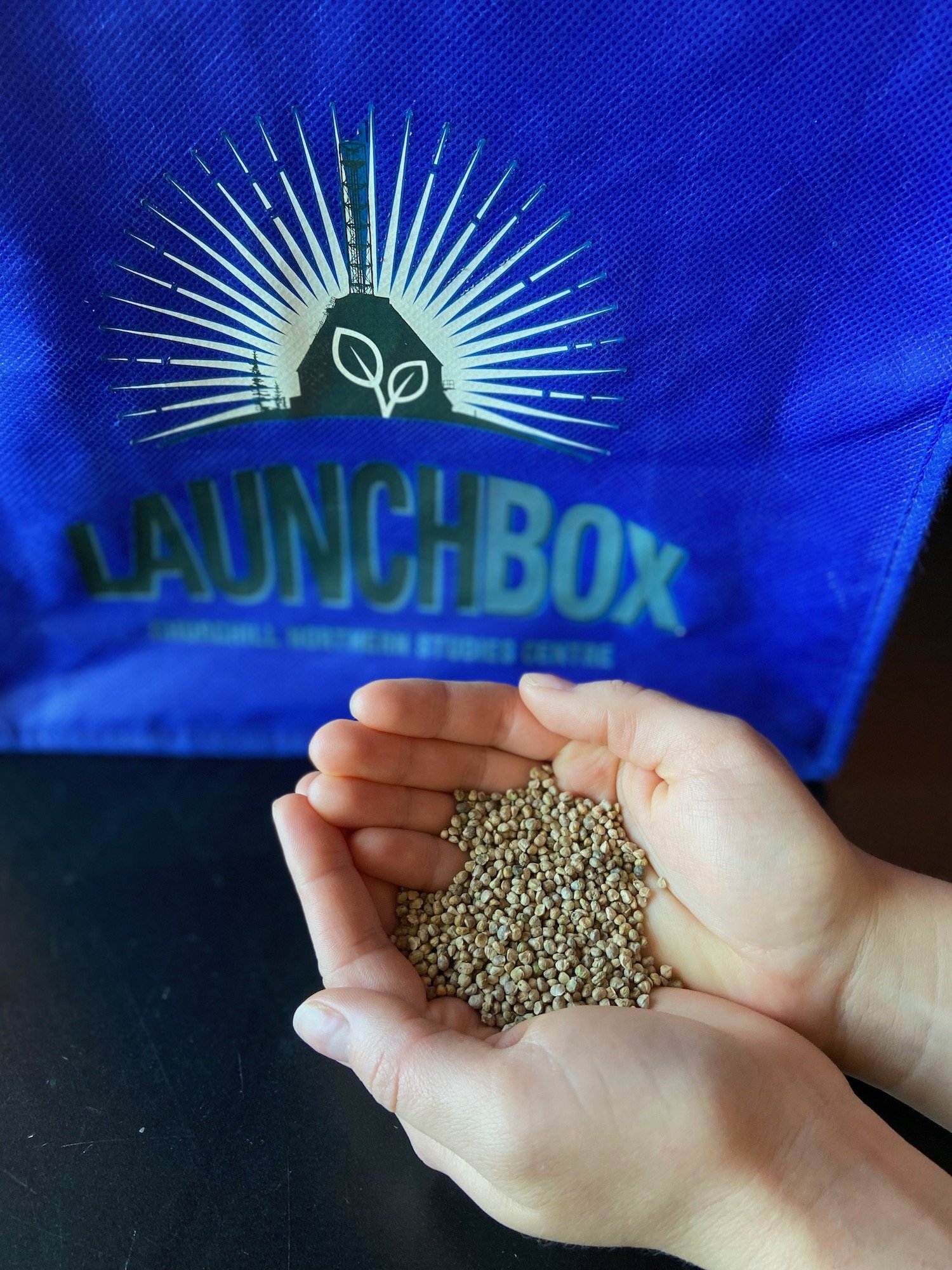Day in a Life of a Grower: Seeding
Have you ever wondered if you have what it takes to grow food year-round using hydroponics?
Step inside a working farm and explore what it’s like to be a hydroponic grower! Fiona with Rocket Greens will document what it’s like to seed, transplant, grow, and harvest in a Growcer modular farm*. Plus, how Rocket Greens distributes their harvest through their subscription box which you can understand by following Fiona on distribution day.
Seeding
Seeding is where it all begins.
Here in Churchill, we start each week with plant care, seeding, and preparing for the week’s harvest. Mondays are always kicked off by sewing seeds.
What we plant changes slightly from season to season, depending on what grows well and what people want to eat. While the environment is controlled in the Growcer modular farm, the farm is still more humid in summer, and cooler and drier in the winter months – just like our weather!

The Churchill Northern Studies Centre’s (home of Rocket Greens) Growcer modular farm on a hot July day.
I find more temperamental varieties (like arugula) do better in shoulder seasons. Lettuce prefers summer months, and kale is a trooper – it seems to grow through anything!
In the last little while we’ve gotten into a great rhythm of planting. We’ve struck the sweet spot where we can grow the right varieties for the conditions, while meeting the needs of our Launch Box subscribers and other customers.
“Lettuce prefers summer months, and kale is a trooper - it seems to grow through anything!”

The various types of seed varieties Rocket Greens grows.
For the most part we rotate the varieties we plant each week. Generally, we have one variety of spinach, kale, bok choy, and lettuce. This week we’re planting Toscano kale, next week will be Red Russian Kale, and then Winterbor Kale after that. We love to mix things up to make sure no two Launch Boxes are the same!
Now. How do we keep track of all this?
Introducing...our seedling book!
<img src="https://images.squarespace-cdn.com/content/v1/6348395313c2ab7c10565062/1665677866404-S3IWU0JFOLHNU9V502VL/Seedling+book+-+1.jpeg" alt="Seedling book - 1.jpeg" />

<img src="https://images.squarespace-cdn.com/content/v1/6348395313c2ab7c10565062/1665677866424-JMSY2EHQG5QXFUKK8RHY/week+28+seeds+-+1.jpeg" alt="week 28 seeds - 1.jpeg" />

#block-ba592b49a1e15bbb314a .sqs-gallery-block-grid .sqs-gallery-design-grid { margin-right: -20px; }#block-ba592b49a1e15bbb314a .sqs-gallery-block-grid .sqs-gallery-design-grid-slide .margin-wrapper { margin-right: 20px; margin-bottom: 20px; }
Our system is pretty low-tech, just pen and paper, since it has worked for us since our very first week. These books contain information on every seed we’ve planted since the earliest days of Rocket Greens (all the way back to November 2017!)
This week, we’re planting two kinds of lettuce: Monte Carlo and Greenstar. This means we will plant fewer “cookable” leafy greens like kale and choy.

Monte Carlo seeds after they’ve grown to become crisp, beautiful romaine lettuce!
Before starting, I like to run a bit of water over each of three rockwool flats - I find the water makes it easier to cut the cubes, and it keeps the rockwool fibres from floating around. These rockwool flats get placed into trays that have holes in the bottom, which allows water to flow through them.

Fiona uses a box cutter to make sure each rockwool cube is separated from its neighbours, making it easier to transplant the plant from the seeding area to the growing racks.
I use a box cutter to make sure each rockwool cube is separated from its neighbours – every flat has 200 cubes in all! Precision is important, because we want to make sure each cube fits nicely into the Growcer farm when it comes time to transplant.
A wet popsicle stick helps when seeding smaller seeds.
The technique I use depends on the seed size: for teeny-tiny ones like mint or arugula, I dampen a popsicle stick, coat it in seeds, and brush a few into each rockwool cube. For small, round seeds I pinch several seeds between my thumb and forefinger, and roll them into their spots.
<img src="https://images.squarespace-cdn.com/content/v1/6348395313c2ab7c10565062/1665677866471-GM0PAGUWS4HL6IRKAH5D/seeding+spinach+-+1.jpeg" alt="seeding spinach - 1.jpeg" />

<img src="https://images.squarespace-cdn.com/content/v1/6348395313c2ab7c10565062/1665677866479-7SD9L8GYX00QB3ZL342E/Seeds+and+launch+box+-+1.jpeg" alt="Seeds and launch box - 1.jpeg" />

#block-f3b975a658d46481886a .sqs-gallery-block-grid .sqs-gallery-design-grid { margin-right: -15px; }#block-f3b975a658d46481886a .sqs-gallery-block-grid .sqs-gallery-design-grid-slide .margin-wrapper { margin-right: 15px; margin-bottom: 15px; }
Getting good at seeding takes time. It used to take me over an hour to do seeding, but these days I can get it all done in 20 to 30 minutes.
These popsicle-stick labels help us understand which variety is where and shows which week of the year they were planted.

Simple labels help growers understand what was planted and when (what week of the year).
The last step is to fully saturate the rockwool with a gentle water flow – gentle so we don’t force the seeds from their spots - and place a plastic dome overtop. The dome acts like a little greenhouse to germinate our new seeds so they will be ready to plant in two weeks’ time.
After the seeds are planted, the next step is to saturate the rockwool with a gentle flow of water.
On Wednesdays, we introduce our seeds to their new home: the Growcer’s seedling area! Here, they will be saturated with their own special concoction of nutrient water and will sprout in a few days.
Happy growing 😊
<img src="https://images.squarespace-cdn.com/content/v1/6348395313c2ab7c10565062/1665677866534-D398HED0JBD02MXLF6J2/Fiona+with+seeds+-+1.jpeg" alt="Fiona with seeds - 1.jpeg" />

<img src="https://images.squarespace-cdn.com/content/v1/6348395313c2ab7c10565062/1665677866525-SZQQNLV6A2MGT2XHO1IQ/2+day+seeds+-+1.jpeg" alt="2 day seeds - 1.jpeg" />

#block-550d5b9da1dcb9a6df59 .sqs-gallery-block-grid .sqs-gallery-design-grid { margin-right: -11px; }#block-550d5b9da1dcb9a6df59 .sqs-gallery-block-grid .sqs-gallery-design-grid-slide .margin-wrapper { margin-right: 11px; margin-bottom: 11px; }
*Because Rocket Greens was Growcer’s first customer, their farm represents an older version of Growcer’s modular farms that uses nutrient film technique (NFT) instead of shallow water culture (SWC) to grow greens. For the latest farm specs and yield data, download your comprehensive guide to Growcer’s farms.

Step inside the farm!
Understand how hydroponic container farms work, from common misconceptions to daily tasks.
hbspt.forms.create({region: "na1",portalId: "3059315",formId: "7539d270-a1c0-4dc7-b571-c8edf9ee1e22"});

